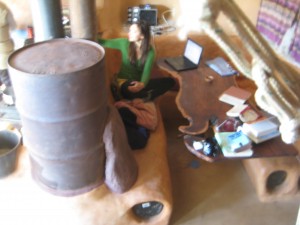 There appears to be a huge amount of traffic and discussion through different internet forums about rocket mass heaters and reports from the authors on sales of the book on the subject confirm this incredible surge in interest. I am quite certain that this excitement stems from the tangible possibility that the rocket mass heater concept offers to individuals and families to build their own affordable efficient wood-fired heating system. I thought it would be interesting and useful to offer the following synthesis of recent research I have been directly involved in and links to information that others have provided to feed more fuel to the fire of this interesting global conversation.
There appears to be a huge amount of traffic and discussion through different internet forums about rocket mass heaters and reports from the authors on sales of the book on the subject confirm this incredible surge in interest. I am quite certain that this excitement stems from the tangible possibility that the rocket mass heater concept offers to individuals and families to build their own affordable efficient wood-fired heating system. I thought it would be interesting and useful to offer the following synthesis of recent research I have been directly involved in and links to information that others have provided to feed more fuel to the fire of this interesting global conversation.
Article Table of Contents:
- The Difference between Rocket Stoves and Rocket Mass Heaters
- The Book on Rocket Mass Heaters
- The MHA Experience
- Construction Processes with Commentary
- Conclusion
- Some Links for Further Reading
The Difference between Rocket Stoves and Rocket Mass Heaters
First, a clarification regarding terms may be useful. The term “rocket stove” and “rocket mass heater” are often used synonymously and interchangeably. Especially as the conversation grows, I think it is worth clearly defining and distinguishing between the two. The rocket part they share in common has to do with insulated J- or L- shaped combustion chambers that allow for a brisk and relatively clean “cigar-type” burn. “Rocket stoves” are usually low in mass and focused on transferring the efficiently generated heat to food or water in pots for cooking or bathing. “Rocket mass heaters” focus the heat generated into heat exchangers that radiate and conduct the heat out into an environment. They often involve a hybrid of a quicker releasing metal heat exchanger (usually a barrel) with a slower releasing, heat-storing battery which offer sustained heat and often takes the form of a bench. This article is about rocket mass heaters and I hope that this distinction in terminology is helpful as we develop a global conversation about these different wood-burning appliances.
The Book on Rocket Mass Heaters

The MHA Experience
During my time working with Ianto at Cob Cottage Company, I became familiar with the Masonry Heater Association of North America and decided to attend their once-a-year gathering in North Carolina. Due to a funny turn of events that involved a full airport parking lot in Denmark and a colleague missing his international flight to come and lead a workshop on one style of masonry heater, I was approached as I arrived and asked if I might lead a hands-on workshop on how to build a rocket mass heater. I accepted the invitation nervously knowing that I would be amongst many grizzled veterans of masonry and wood-fired heating. Well, as things go, the location chosen for the rocket mass heater was on the periphary, next to the lime-burning kiln that was being built in an adjacent workshop. We screeded sand to begin building on and laid up a classic J-shaped “rocket” combustion chamber.
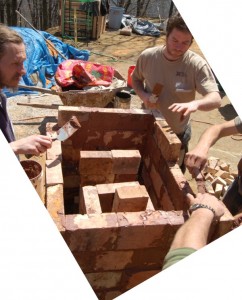 Alex Chernov, a remarkably accomplished mason, came over and said: “Why don’t we put a bell around it?” I honestly hadn’t even heard of what a “bell” was in the context of masonry heating but the spirit of collaboration was rife and within a couple of hours we had built and lit a fire in a hybrid heater that combined years of experience gleaned in the temperate rainforest of Oregon with other experiences developed through long winters in Russia through the happy coincidence of people meeting and working together.
Alex Chernov, a remarkably accomplished mason, came over and said: “Why don’t we put a bell around it?” I honestly hadn’t even heard of what a “bell” was in the context of masonry heating but the spirit of collaboration was rife and within a couple of hours we had built and lit a fire in a hybrid heater that combined years of experience gleaned in the temperate rainforest of Oregon with other experiences developed through long winters in Russia through the happy coincidence of people meeting and working together.
The most significant circumstance, though, was that that night happened to be a very cold night. The crew that manned the lime kiln through the night stayed very close to the heater and built wooden benches on either side of the bell to sit near it. The tangible usefulness of this quickly and simply-built heater, along with the rain, inspired us to continue experimenting. We ripped that heater down the very next morning, moved inside, and started building another one that would keep our group warm through that particularly cold annual gathering.
There are many stories that can be told but the one that I want to share here is about the experimentation on rocket mass heaters that I have experienced in large part through the collaborative and inquisitive spirit and support of members of the Masonry Heater Association. The experimentation takes the concepts introduced in the Rocket Mass Heater book as a starting point. This research differs in its use of brick rather than cob as its primary building block and in a departure from adherence to the idea that the flue path need to have a consistent cross-sectional area through the system.
Construction Processes with Commentary
The commentary only really makes sense if you first study the photo reports in these links:
Rocket Mass Heater Build at WildAcres 2009:
You actually see two rocket mass heaters built in this sequence. The first shows the very simple bell heater that was built. The bricks you see inside the bell were placed there to support “capping slabs” that weren’t big enough to span the whole distance as well as provide more thermal mass and baffling inside the bell.
The second heater was designed as we went and with consideration for the materials that we had. The rather confusing stove pipe was placed simply to test out the j-loop. We had originally planned to build a similar, if not larger bell, on the second one but when it became obvious that we needed to redirect bricks to the oven-building effort so that the oven could be completed for the annual pizza party, we de-constructed some of the bell and turned it into a bench. This turned out to be a great idea. The icing on the cake was to use the lime we had created a couple of days before to plaster the hot heater.
As several have commented, it was very surprising how well and hard that lime plaster set considering that it is contrary to conventional knowledge that a lime plaster applied to a piping hot surface and that dried in less than a minute would create such a stiff shell. We did not experience any cracking on this plaster single skin although it never really went through a cycle of cooling down and heating up since it was torn down while still hot. There was a lot of magic in this heater. Part of it came from the spontaneity and cooperative spirit in which it was born. Part of it from the synergy with the incredible lime plaster and the artists who helped render it. And a huge part of it was the real butt-warming heat it gave so many of us during a very cold and merry event.
Masonry Rocket Mass Heater at Wildacres 2010:
This was an interesting project. Jerry Frisch basically gave me free reign with materials and shop space to experiment and invent a heater that combined experience from both the rocket mass heater world and the masonry heater world. The heater’s design took into consideration people’s curiosity about alternatives to using a 55-gallon metal drum as well as the possibility of incorporating a safer, more enclosed, more visible, higher volume firebox. The brick work necessary to work in round shapes was perhaps overly fancy, especially considering that I cut all the bricks rather than sourcing an arch brick that would fit the shape.
You can see that we maintained the idea of an insulated heat riser by insulating with perlite between a stainles steel pipe and ceramic square flue liners. The combined layer of splits and fulls on the outside are a little confusing and reflect a token effort at addressing code considerations of a minimal thickness on the outside skin. The bench surrounding the heater was a little too shallow in retrospect and in general the heater was a little too delicate for my taste.
When Jerry burned it in his shop after a drying period, he noticed that the fire wasn’t getting enough air from the air-supply in the door. When we built it at WildAcres, we included Jerry’s suggestion of incorporating additional air in such a way that encouraged a vortex for improved mixture in the combustion process. In general, I think there were some interesting ideas explored in this heater but that it was the least succesful.
Impromptu Rocket Mass Heater at WildAcres 2011:
At this WildAcres, I had resolved not to be involved in a project in order to participate and learn from others’. Well, by the third day or so the buzz about a “Rocket” was escalating and Kathleen mustered enough committed volunteers for us to attempt another. This was my favorite build of this series. We literally threw this rocket mass heater together during the two hours before and two hours after lunch on a single day. There was absolutely no planning done beforehand and the basic layout was sketched out in real time on the ground as the bricks dictated a brick-based layout that was simple and required almost zero cutting for the entire project.
The basic premise of this heater was to really test the bell idea by making the volumes inside much bigger than would be determined by following the idea of having a consistent cross-sectional area throughout the system. Unfortunately, I am not sure that there are any decent photos of this heater finished which essentially show that it worked well, that it burned clean and easily, and that people enjoyed its heat. Note that there are two passage ways on either side of the heat riser that allow gases to pass from the first bell into the bench bell.
Conclusion:
The main conclusion of this essay is to affirm the application of the “bell” design principle to the construction of “rocket” mass heaters. It is a promising and interesting direction. Maintaining a consistent cross-sectional area in the flue path of a rocket mass heater, as set forth in Ianto and Leslie’s book, is not the only way to design a rocket mass heater that is successful and works well.
Some Links for Further Reading:
- Get the original book on Rocket Mass Heaters!
- The website of Leslie Jackson, co-author of the book on Rocket Mass Heaters
- A Basic Description of the Bell Design Principle by Alex Chernov
- A Paper by Igor Kuznetsov Introducing the Ideas of Free Gas Flow and the Bell system
- Interesting Information on Rocket Mass Heaters presented by Erica & Ernie Wisner
- Rocket Stove & Rocket Mass Heater Forum Moderated by “Donkey”
- A Study by Ksenia Chumakova & Norbert Senf of Temperatures and Flow in a Rocket Bell
- “Riding the Russian Rocket”, an essay by Alex Chernov
Photo Credits: Norbert Senf, John Rousseau
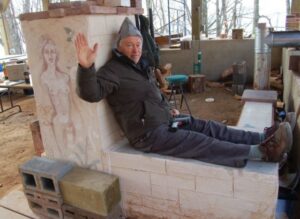
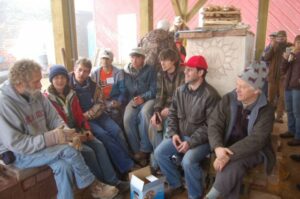
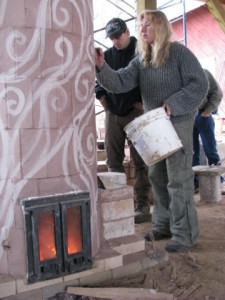
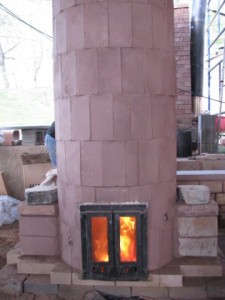
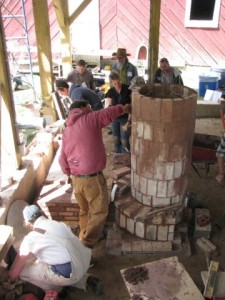
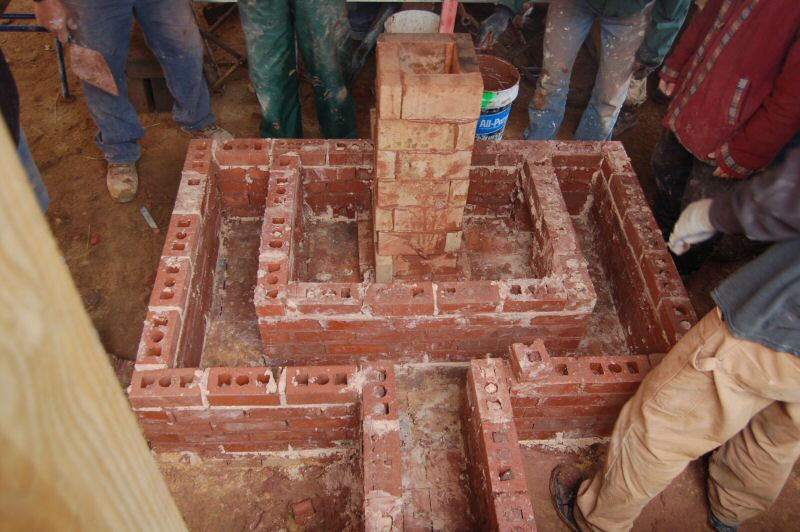
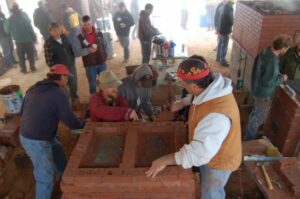
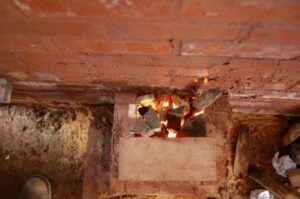
Can we have an up date on your heater.
You might want to look up the Masonry Heater Association website, especially their extensive resources page, and Max Edleson’s Firespeaking site.
Thanks so much for your writeup. It’s hard to find info on the bell style. I’m hosting a workshop in 2018 where we are going to build a bell rocket mass heater. Join us for a Rocket Mass Heater Workshop w/Uncle Mud. Aug 25-26, 2018. Fairfield, PA. More info at http://www.RocketMassHeaterWorkshop.com. Hope to see you there!
Check out this link.
The mass heater idea has been around since neolithic times.
In China and Manchuria it is called the Kang.
In Korea it is called Ondol.
Basicaly the flue for the home cooking fire flows thru a raised platform (Kang) upon which people sit to keep warm and frequently sleep on. If this system is used to heat an entire room (as in Korea) it is commonly called Ondol. The ondol floor was one of the first uses of paper and seasami oil (linolium) which covered the floor and sealed out the deadly carbon monoxide. In traditional Korean houses this method produced a lovely dark yellow flooring that was sometimes so hot you had to wear slippers to keep cool enough to stand on.
http://www.koreatimesus.com/korean-ondol-or-chinese-kang/
also
https://duckduckgo.com/l/?kh=-1&uddg=https%3A%2F%2Fen.wikipedia.org%2Fwiki%2FKang_bed-stove
There are some nice Face Book chat rooms helping folks that are building their rocket stoves
one run by Leslie Jackson and Dyanna Zimmer “Rocket Mass Heaters ” ( eng )
one run by Pieter Abts and me “Rocket Stoves /Rocket Mass Heaters International”(eng , nl)
one run by Alejandro Groenenberg and Pablo Ok “Mardelfuego ” (port)
then there are some more groups like showing off build heaters in the I like section “I fucking love Rocket Stoves , Dragon Heaters ,Exciting Rockets, Leen & Vuur -Rocket Stove Workschops,Africa kitchen revolution , Sun Dog school of natural building , Rocket Stove Mass Heaters ,Rocket Stove ,Hurricane Ridge Rocket Stoves , NB Rocket Mass Heaters Enthusiasts , … ” there probably more out there but this what I found out there . I hope some folks find new interesting FB links here
if you have more links on FB-pages please post them here thanks
kind regards,Karl
oeps mardelfuego is in spanish as i not master either of them ,they resemble to me , my excuses
Here is a review by donkey of the dragonheater core using a barrel and a bell in a very small foot print.
http://donkey32.proboards.com/thread/803/evaluating-6-dragon-burner
Thanks for this post Sandy. This does look like an interesting option for minimizing the size of the burn apparatus by using something pre-fabricated for the purpose. It is fascinating to watch the rocket mass heater concept slowly achieve more recognition and to see new products like this one complement the completely do-it-yourself approach. My sense is that well-thought fabricated options can minimize mistakes which might help the rocket pattern continue to become more popular. I also think it’s neat that the original concept requires almost nothing else other than some firebrick for its construction. Donkey’s prototype is neat in its use of adobes without stove pipe. Here is a link to a rocket mass heater that I built that similarly used adobes and has been very succesfully working for 3 years now. The main things that I am trying to include in my builds and encourage other people to do is to provide adequate cleanouts to be able to clean out the inside of the stove and I have found that a cleanout at the bottom of the exit chimney that doubles as a primer for tricky start-up conditions is pretty much necessary in a good design.
Great thread. (It is still growing by the way) having a premade core is one of the first steps to being able to include one in a permit built home. Of course the requirement of a certified mason to finish it off might still kill it for most people. 18 inch barrel is nice… lots easier to find around here… AKA water heaters. So far as I can tell, adding mass to the barrel doesn’t effect performance and pulls down the radiated heat some (a lot actually).
Good site! Are there any rocket heater forums out there? Very interested in building my own rocket heater. I found a company that makes rocket heater cores. Anyone here have experience with http://www.dragonheaters.com. There cores are made here in the USA
look up http://donkey32.proboards.com/ — comprehensive, diverse, w/amazing leadership from some really good designer/builder/tinkerers…
I like Rocket Mass Heater . I want learn how to build RMH ? I live in Nepal at forest village . Where can I buy book ?
Hi Babu, You can get the Rocket Mass Heater book via this link.
Thank you for posting this. I have followed the various builds at the MHA website and even pointed people to them who did not want a barrel in their living room. However, this is the first time I have read your comments on each of the builds and that completes things.
I have used two of the ideas you talk about (sort of). I have used mass on the outside of the barrel in much the same way you have built the barrel out of brick. In my case, I don’t have fire brick to play with and so I used a steel container (water heater core) and dry stacked common brick around it with wire to hold it against the core. This seemed to work well, that is, it draws well and there is no smoke.
The second thing I have done is to use a bell for my heat storage bench. In this case I took a second water heater core and cut it lengthwise. The round part is down and I have put patio blocks on top to store the heat. The exhaust from the “barrel†goes into the top and comes out the bottom to go to the flue. This seemed to work very well as even at only 4 feet long it dropped the flue gas temperature dramatically. And yes it felt good to sit on.
My idea is that I want to use a steel core that is sealed from end to end and yet not cost a lot. So I have used old water heater cores which are not recycled here and free for the taking and standard stove pipe as the original RMH. I don’t have much land and so cob becomes more expensive than brick very quickly. I am also thinking I want a temporary install so being able to “Dry stack†the mass is helpful… I want to take it with me when I move. The other benefit of dry stack is that the mass can be changed seasonally… though I have yet to see if this really would be useful.
I am waiting for the next edition of the RMH book to buy it as I have been following some of Ernie’s work and believe it to be worth the wait. He has built many experimental bits to try new things out and find out what doesn’t work too.
You state that someone suggested putting a “bell†around your heater, and that you were unfamiliar with a “bell†in masonry heating. I’m still not sure I understand what a “bell†is. Can you explain what the bell encloses? Are exhaust gasses, or clean air, or both being moved through the bell? A simple sketch would help immensely.
I added the links at the bottom since you wrote, in particular Alex Chernov’s and Igor Kuznetsov’s to provide more information about the bell system. Yes, a sketch would be helpful and possibly on the way.